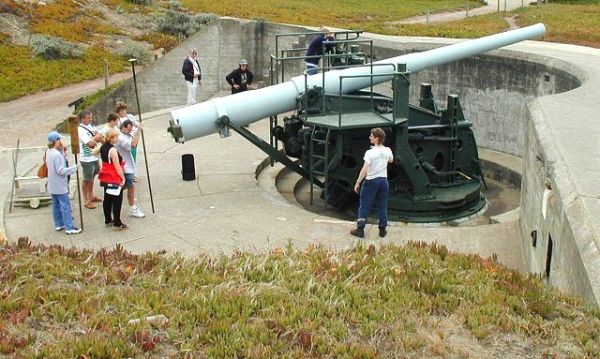This little manual covers a lot of advanced topics such as geodesy, survey, coordinate determination, even astronomical observations using theodolites. It's a pretty intensive manual, chock full of weighty Engineer topics.
Only it's not an Engineer manual. I was surprised and bemused to see that it was published in 1941 under the direction of the Chief of Coast Artillery. Huh? Coast Artillery?
So what did the Coast Artillery mean when they used the term 'orientation'?
Definition - The term orientation as used in the Coast Artillery Corps means:
a. The accurate location of datum points and the establishment of ines of known length and direction.
b. The adjustment of the azimuth indicating devices on guns and observing instruments when the axis of the line of sigh is pointed at that azimuth.
Application - In its application to artillery, the term orientation includes the following:
a. The determination of the meridian for the measurement of azimuths.
b. The determination of the coordinates of the directing point, observing stations and spotting stations for a battery.
c. The determination of the length and azimuth of base lines and director offsets.
d. The establishment of such reference and datum points as may be necessary.
(TM 4-225 Orientation, paragraph 2. a. & b.)
For those not aware, since the founding of our country right up until the mid-20th Century our key harbors and coastline sections have been overwatched by large artillery pieces, designed and situated to destroy enemy vessels intent on entering our harbors and waterways and doing damage. In fact, one of the earliest jobs of the Corps of Engineers was the construction of harbor and waterway defenses and the siting and preparation of the firing positions for these coastal artillery guns. However, it wasn't until 1901 that the Army recognized the key differences between the missions of the coast artillery and field artillery by establishing the Coast Artillery Corps as a separate branch.
Modern field artillery has always had a strong need for surveyors. As the concepts of indirect artillery fire matured and rifled cannon delivered the ability to fire projectiles far beyond the visual range of the gun crews the need for surveyors to accompany and support field artillery units emerged. After all, to accurately hit a target you can't see you first have to know precisely where you are. Many of the concepts covered in this little manual are directly applicable to field artillery survey. But we are talking about field artillery - guns that get towed around the battlefield by trucks, set up, shoot some shells then pack up and move to the next firing position. Coast Artillery is a different beast. It operated large, permanently placed guns overlooking harbors and waterways that were already precisely mapped. Why the need for more advanced surveying and mapping techniques? The answer is laid out in Section (Chapter) IX of the manual, where it discusses the duties of the Battalion Reconnaissance Officer.
It appears that not all Coast Artillery cannon were permanently mounted. At the time of publication the Coast Artillery Branch either had or was anticipating use of mobile 155-mm artillery, railway artillery and anti-aircraft guns. It would be the responsibility of the Reconnaissance Officer and his reconnaissance parties to find new gun locations, work out their proper positioning (orientation) and if necessary map the the new areas of coverage so the gunners knew where they were shooting.
The battery reconnaissance officers, under the supervision of their battery commanders, compute the data necessary for the orientation of the plotting boards and complete the organization of the battery plotting rooms and observing stations. The battery executives, utilizing the orienting lines supplied them, orient the guns of their batteries.(TM 4-225, paragraph 49. e.)
While coastal defense was a huge mission during WWII, and the Coast Artillery branch provided a key service to the nation, it quickly became apparent that aircraft were a far more effective coastal defense tool than land-based artillery. By the end of the war long range bombers and radar made fixed coastal defense sites obsolete. In 1950 the US Army dissolved the Coast Artillery branch and absorbed its officers and enlisted personnel into the regular Field Artillery branch. Today all that remains of a once proud branch of the US Army are some abandoned casements dotted along the Atlantic and Pacific coasts, and at the Presidio of San Francisco you can still view an original 'disappearing' coastal defense gun at Battery Chamberlin.
 |
| Battery Chamberlin The Presidio of San Francisco |
Brian



2 comments:
Marcis, it looks like your friend has what is referred to as a hand bearing compass. It is hard to tell the size since there's nothing in the picture to provide a scale. Is there a handle on the underside of the compass? Perhaps a tube that holds batteries? The long slender piece on the left side that has the slit cut in it is the sighting vane. The object on the right is a sighting prism, which allows the compass to be read when held at eye level. Hope this helps!
Brian
Post a Comment